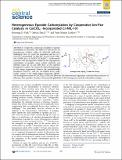Heterogeneous Epoxide Carbonylation by Cooperative Ion-Pair Catalysis in Co(CO)
Author(s)
Park, Hoyoung Daniel; Dinca, Mircea; Roman, Yuriy
Downloadacscentsci.7b00075.pdf (795.6Kb)
PUBLISHER_POLICY
Publisher Policy
Article is made available in accordance with the publisher's policy and may be subject to US copyright law. Please refer to the publisher's site for terms of use.
Terms of use
Metadata
Show full item recordAbstract
Despite the commercial desirability of epoxide carbonylation to β-lactones, the reliance of this process on homogeneous catalysts makes its industrial application challenging. Here we report the preparation and use of a Co(CO)₄ - -incorporated Cr-MIL-101 (Co(CO)₄ Cr-MIL-101, Cr-MIL-101 = Cr₃O(BDC)₃F, H₂BDC = 1,4-benzenedicarboxylic acid) heterogeneous catalyst for the ring-expansion carbonylation of epoxides, whose activity, selectivity, and substrate scope are on par with those of the reported homogeneous catalysts. We ascribe the observed performance to the unique cooperativity between the postsynthetically introduced Co(CO)₄ - and the site-isolated Lewis acidic Cr(III) centers in the metal-organic framework (MOF). The heterogeneous nature of Co(CO)₄ Cr-MIL-101 allows the first demonstration of gas-phase continuous-flow production of β-lactones from epoxides, attesting to the potential applicability of the heterogeneous epoxide carbonylation strategy.
Date issued
2017-03Department
Massachusetts Institute of Technology. Department of Chemical Engineering; Massachusetts Institute of Technology. Department of ChemistryJournal
ACS Central Science
Publisher
American Chemical Society (ACS)
Citation
Park, Hoyoung D., Mircea Dincă, and Yuriy Román-Leshkov. “Heterogeneous Epoxide Carbonylation by Cooperative Ion-Pair Catalysis in Co(CO)₄–-Incorporated Cr-MIL-101.” ACS Central Science 3, 5 (March 2017): 444–448 © 2017 American Chemical Society
Version: Final published version
ISSN
2374-7943
2374-7951